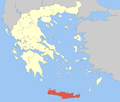Kissamos
| Kissamos Κίσσαμος | |
|---|---|
 Kissamos | |
 Kissamos Location within the region 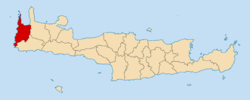 | |
| Coordinates: 35°29′N 23°39′E / 35.483°N 23.650°ECoordinates: 35°29′N 23°39′E / 35.483°N 23.650°E | |
| Country | Greece |
| Administrative region | Crete |
| Regional unit | Chania |
| Government | |
| • Mayor | Theodoros Stathatkis |
| Area | |
| • Municipality | 341.0 km2 (131.7 sq mi) |
| • Municipal unit | 149.0 km2 (57.5 sq mi) |
| Population (2011)[1] | |
| • Municipality | 10,790 |
| • Municipality density | 32/km2 (82/sq mi) |
| • Municipal unit | 7,579 |
| • Municipal unit density | 51/km2 (130/sq mi) |
| Community[1] | |
| • Population | 4,275 (2011) |
| Time zone | UTC+2 (EET) |
| • Summer (DST) | UTC+3 (EEST) |
| Postal code | 734 00 |
| Area code(s) | 28220 |
| Vehicle registration | ΧΝ, XB |
| Website | |
Kissamos (Greek: Κίσσαμος) is a town and municipality, multiple (former) bishopric and Latin titular see in the west of the island of Crete, Greece. It is part of the Chania regional unit and of the former Kissamos Province which covers the northwest corner of the island. The city of Kissamos is also known as Kastelli Kissamou and often known simply as Kastelli after the Venetian castle that was there. It is now a port and fishing harbour, with a regular ferry from the Peloponnese via Kythira. A town museum is located in the old Venetian governor's palace and there have been important archaeological finds in the town, including fine mosaics, dating from the Roman city of Kisamos (Κίσαμος, Latinized as Cisamus). The head town of the municipality (Δήμος Κισσάμου) is Kastelli-Kissamos itself.
History
Strabo said that ancient Cisamus was dependent on Aptera and was its naval arsenal.[2] The Peutinger Table distinguishes two port towns in Crete called Cisamus,[3] Modern Kissamos (at 35°29′38″N 23°39′25″E) is much further west than where Aptera is now placed (at 35°27′46″N 24°8′31″E). It was excluded already by Pashley in 1837 as being, of the two ancient maritime Cretan cities named Kisamos, the one associated with Aptera.[4] In the past, when the port of Aptera was thought to be present-day Kissamos, some supposed Aptera to be identical with Polyrrhenia, and Kissamos to be the port of Polyrrhenia.[5] However, Strabo and other ancient sources say that Polyrrhenia's port was at Phalasarna on the west coast.[6][7]
Ecclesiastical history
.jpg)
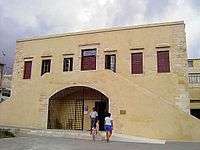
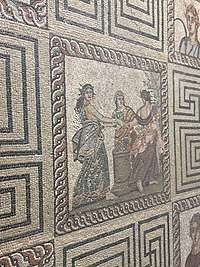
Ancient Cisamus became a Christian bishopric, a suffragan of the metropolitan see of Gortyna, the capital of the Roman province of Crete. Only two of its first-millennium bishops are named in extant contemporary documents: Theopemptus (according to 18th-century Lequien), Nicetas (according to 20th-century Janin) at the Trullan Council in 692, and Leo at the Second Council of Nicaea in 787.[8]
Orthodox bishopric
The bishopric is still a residential see of the Eastern Orthodox Church of Crete.[8]
Latin diocese
After the Venetian conquest of Crete in 1212, Cisamus became a Latin Church diocese. The names of more than 20 residential Latin bishops from then until the end of the 16th century are known, including :[9][10][11]
- Suffragan Bishops of Kisamo
(incomplete)
- ...
- Angelo Barbarigo (1383 – 1406.09.21), later Bishop of Verona (Italy) (1406.09.21 – death 1408.09.19), Cardinal-Priest of Ss. Marcellino e Pietro (1408.09.19 – 1418.08.16), also Cardinal-Priest of S. Prassede in commendam (1415.07.04 – 1418.08.16
- ...
- Prospero Santacroce (1548.03.22 – 1572?resigned), Apostolic Nuncio (papal ambassador) to Austria-Hungary (1548.04.05 – 1550.04.25), Apostolic Nuncio to France (1552.07.15 – 1554.05.23), Apostolic Nuncio to Portugal (1560.07.06 – 1561.05.10), again Apostolic Nuncio to France (1561 – 1565), created Cardinal-Priest of S. Girolamo degli Schiavoni (1566.02.08 – 1570.04.12), Apostolic Administrator of Arles (France) (1566.06.17 – 1574), transferred repeatedly Cardinal-Priest of S. Maria degli Angeli (1570.04.12 – 1574.05.05), Cardinal-Priest of S. Adriano al Foro pro hac vice Title (1574.05.05 – 1583.03.04), Cardinal-Priest of S. Clemente (1583.03.04 – 1589.03.02), promoted Cardinal-Bishop of Albano (1589.03.02 – 1589.10.02)
- Apostolic Administrator Gerolamo Ragazzoni (1572.12.10 – 1576.09.19), former Coadjutor Bishop of Famagosta (Cyprus, 1561 – 1571), Bishop of Novara (Italy) (1576.09.19 – 1577.07.19), Bishop of Roman Catholic Diocese of Roman Catholic Diocese of Bergamo&Bergamo (Italy) (1577.07.19 – death 1592.03.17), Apostolic Nuncio (papal ambassador) to France (1583 – 1586)
Titular see
No longer a residential bishopric, Cisamus is today listed by the Catholic Church as a titular bishopric,[12] (Curiate Italian Cisamo) since it was suppressed as residential see around 1600 AD.
It has been vacant for decades, having had the following (often not consecutive) incumbents, all of the lowest (episcopal) rank :
- Fortunato Bisleti (1728.11.15 – 1749), no office recorded
- Miguel Anselmo Álvarez de Abreu y Valdéz (1749.09.22 – 1765.04.22), as Auxiliary Bishop of Tlaxcala (Mexico) (1749.09.22 – 1765.04.22); later Bishop of Antequera (Mexico) (1765.04.22 – 1774.07.25)
- Jan Pettani (1767.02.05 – death ?) as emeritate, former Bishop of Šibenik (Croatia) (1763.07.18 – 1767.02.05)
- Martin Nugk von Lichtenhoff (1775.11.15 – 1780.06.21), as Apostolic Prefect of Lausitz (Germany) (1774.01.17 – death 1780.06.21)
- José O.S. Casquete Prado (1797.12.18 – death 1838.02.02); no office recorded
- Dominik Mayer (1863.10.01 – death 1875.05.04), as Military Vicar of Austria (Austria) (1863.10.01 – 1875.05.04)
- Adrien-François Rouger (王吾伯), Lazarists (C.M.) (1883.09.07 – 1887.03.31)
- Thomas William Wilkinson (1888.05.15 – 1889.12.28)
- Charles Maurice Graham (1891.09.25 – 1902.10.25)
- Jean Muradian (1905.08.07 – 1911.07.11)
- Heinrich Joeppen (1913.10.27 – 1920.02.22)
- Lajlo Budanovic (1927.02.28 – 1958.03.16)
- Nikollë Troshani (1958.04.18 – death 1994.05.25), Apostolic Administrator of Durrës (Albania) (1958.04.18 – 1992) and on emeritate
Municipality
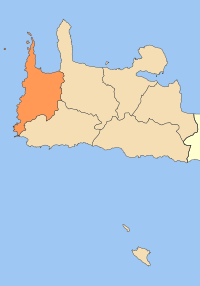
The municipality of Kissamos was formed at the 2011 local government reform by the merger of three former municipalities, which became municipal units:[13]
The municipality has an area of 341.018 km2 (131.668 sq mi) and the municipal unit has an area of 149.034 km2 (57.542 sq mi).[14] The municipal unit of Kissamos includes the Gramvousa peninsula (Chernisos Gramvousas Χερσόνησος Γραμβούσας) in the northwest and the adjacent Gramvousa islets, as well as the islet of Pontikonisi, and the villages of Sfinari, Koukounaras, Polirinia, Platanos, Lousakia, Sirikari, Kallergiania and Kalathena. It forms the extreme western part of the region, and of Crete. It is bordered by Platanias to the East, and by Kantanos-Selino to the south.
Former province
The province of Kissamos (Greek: Επαρχία Κισσάμου) was one of the provinces of the Chania Prefecture. Its territory corresponded with that of the current municipality of Kissamos, and the municipal units of Kolymvari and Voukolies (partly).[15] It was abolished in 2006.
Notable locals
- Manos Katrakis (1908–1984), actor
- Giorgis Koutsourelis (1914–1994), Cretan music composer
See also
References
- 1 2 "Απογραφή Πληθυσμού - Κατοικιών 2011. ΜΟΝΙΜΟΣ Πληθυσμός" (in Greek). Hellenic Statistical Authority.
- ↑ J.A. Cramer, A Geographical and Historical Description of Ancient Greece (1828), Vol. 3, pp. 364, 379
- ↑ John D. Pendlebury, The Archaeology of Crete (Biblo & Tannen 1969 ISBN 978-0-81960121-6), p. 21
- ↑ Robert Pashley, Travels in Crete (J. Murray 1837), vol. 1, pp. 49, 55
- ↑ Edward Falkener, A Description of Some Important Theatres and Other Remains in Crete (Trübner 1854), p. 26
- ↑ Pendlebury (1969), p. 14
- ↑ J.A. Cramer, A Geographical and Historical Description of Ancient Greece (1828), Vol. 3, p. 364
- 1 2 Raymond Janin, v. Cisamus, in Dictionnaire d'Histoire et de Géographie ecclésiastiques, vol. XII, Parigi 1953, coll. 844-845
- ↑ Konrad Eubel, Hierarchia Catholica Medii Aevi, vol. 1, pp. 185–186; vol. 2, p. 127; vol. 3, p. 166; vol. 5, p. 158; vol. 6, p. 166; vol. 8, pp. 205–206
- ↑ "Diocese of Kisamos" Catholic-Hierarchy.org. David M. Cheney. Retrieved February 29, 2016
- ↑ "Titular Episcopal See of Cisamus" GCatholic.org. Gabriel Chow. Retrieved February 29, 2016
- ↑ Annuario Pontificio 2013 (Libreria Editrice Vaticana 2013 ISBN 978-88-209-9070-1), p. 870
- ↑ Kallikratis law Greece Ministry of Interior (in Greek)
- ↑ "Population & housing census 2001 (incl. area and average elevation)" (PDF) (in Greek). National Statistical Service of Greece. Archived from the original (PDF) on 2015-09-21.
- ↑ "Detailed census results 1991" (PDF). Archived from the original (PDF) on 2016-03-03. (39 MB) (in Greek) (in French)
Sources and external links
| Wikimedia Commons has media related to Kissamos. |
See Chania Region for maps
